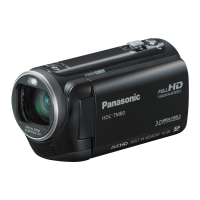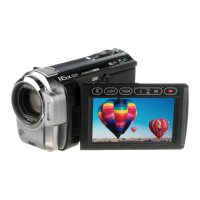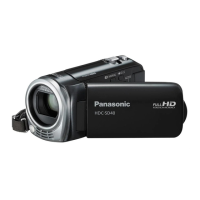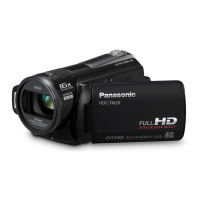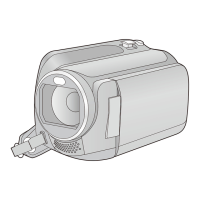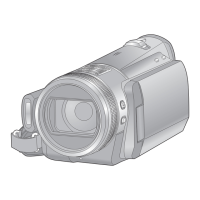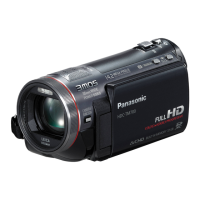
Do you have a question about the Panasonic HDC-TM60 and is the answer not in the manual?
| Digital zoom | 1500 x |
|---|---|
| Optical zoom | 25 x |
| Image stabilizer | Yes |
| Focal length range | 3.02 - 75.5 mm |
| Focal length (35mm film equivalent) | 35.7 - 893 mm |
| Sensor type | MOS |
| Total megapixels | 3.32 MP |
| Optical sensor size | 1/4.1 \ |
| Interface | AV multi |
| Power consumption (typical) | 4.4 W |
| Display diagonal | 2.7 \ |
| Maximum video resolution | 1920 x 1080 pixels |
| Still image resolution(s) | 2592 x 1944 |
| Camera shutter speed | 1/25 - 1/8000 s |
| Minimum illumination | 1 lx |
| USB 2.0 ports quantity | 1 |
| Flash memory | 16 GB |
| Product color | Black |
| Bundled software | HD Writer AE 2.0 |
| Depth | 112 mm |
|---|---|
| Width | 51.5 mm |
| Height | 65.5 mm |
| Weight | 258 g |
Information regarding the unit's compliance with electromagnetic compatibility standards.
Guidance on the disposal of electronic equipment in regions outside the EU.
Panasonic's disclaimer regarding loss or damage to recorded content.
Guidelines for safely using the 16 GB built-in memory.
Precautions for using the 120 GB HDD, including shock and temperature sensitivity.
Details on compatible SD card types, capacities, and recording compatibility.
Explanation of symbols and conventions used in the manual.
Diagrams and labels identifying external controls and connectors for specific models.
Instructions for installing and removing the unit's battery.
Procedure for charging the camera's battery using the AC adaptor.
Information on battery charging durations and recording times.
Details on compatible SD card types, capacities, and recording compatibility.
Instructions on powering the unit on and off using the dedicated power button.
Instructions on using the LCD monitor to power the unit on and off.
Guidance on operating the unit via the touch screen interface.
Instructions for using the camera to record yourself.
Guidance on holding the camera correctly for stable recording.
Tips for steady and smooth motion picture recording.
Understanding the visual cues for focus status during still picture capture.
Identifying the area on screen used for focusing.
How the camera automatically focuses and situations where it may not work.
Explanation of automatic white balance functions and manual adjustment.
Information on how the guide display provides descriptions and confirmations.
Configuring screen display options and setting the current time/world time.
Information on using the camera's extra optical zoom feature for enhanced magnification.
How to adjust the optical image stabilizer settings using the dedicated button.
Understanding the target frame and its behavior during AF/AE tracking.
How to operate the video light using its button and available settings.
Overview of various icons used to apply effects to images during recording.
Modifying details of previously registered faces.
Removing registered face information from the unit.
Manual control over focus to achieve precise subject sharpness.
Adjusting white balance for accurate color reproduction under various lighting.
Controlling shutter speed and aperture for exposure and motion blur.
Controlling motion picture playback using on-screen icons for fast forward, rewind, etc.
Setting playback to loop automatically after the last scene.
Continuing playback from where it was last stopped.
Magnifying still pictures on the screen during playback.
Organizing and playing back recorded content based on the date it was captured.
Extracting and playing back segments featuring recognized faces with added music.
Extracting and playing back key segments from long recordings with added music.
Playing back scenes automatically selected for interest, excluding errors.
How to select and delete multiple scenes or still pictures from the thumbnail view.
Deleting scenes or pictures after previewing them.
Removing face recognition data from recorded scenes.
Preventing accidental deletion of important scenes or pictures.
Steps for connecting the camera to a television for viewing content.
Adjusting display for 4:3 TVs or when images don't fit screen.
Controlling the visibility of on-screen display elements on the TV.
Instructions for connecting the unit to a TV using an HDMI cable.
Steps to connect the unit to a VIERA Link enabled TV via HDMI for linked operations.
Checking available space on the SD card, built-in memory, or HDD before copying.
Procedures for copying data between different storage media.
Information on recommended DVD burners and compatible discs for copying.
List of disc types supported for copying and playback.
Initializing DVD-RAM, DVD-RW, and +RW discs.
Enabling write protection for copied discs to prevent accidental deletion.
Viewing details about the recorded disc, such as finalization status.
Transferring motion and still picture data from the camera to a PC's hard drive.
Copying video content to discs in various quality formats.
System requirements for installing and running the HD Writer AE 2.0 software.
How to access and read the detailed PDF user manuals for the software.
Explanation of icons and status indicators shown during recording.
Icons and symbols displayed during playback operations.
Icons showing connection status with external devices like PCs or card readers.
Specific indicators shown when a DVD burner is connected.
Details on using the AC adaptor, including warnings and maintenance.
Troubleshooting common charging issues indicated by status lights.
Instructions for physically formatting SD cards before disposal.
Tips for cleaning and maintaining the LCD monitor screen.
